Virginia Department of Education
Mathematics Vocabulary Cards - Grade 2
Augment your math curriculum with posters detailing several concepts important to second grade math. Each poster features one math term from geometry, measurement, probability and statistics, computation and estimation, numbers and...
Curated OER
Boxes, Bottles, and Mugs
In this balancing a scale learning exercise, 3rd graders study and analyze a set of scales and determine how many mugs would be needed to balance the last scale in each set.
Virginia Department of Education
Equations
Science equipment can be handy for math class, too. Scholars learn to solve one- and two-step linear equations by using the concept of a balance. They solve real-world problems in a variety of contexts by writing and solving linear...
Curated OER
Equations in the Park
Young scholars explore algebraic concepts using real life situations. In this equations lesson, students develop strategies to solve missing number problems. Young scholars participate in a board game based on algebraic equations.
Curated OER
Visualizing Integers
Students create visuals on the TI Calculator to solve problems. In this algebra lesson, students perform basic operations with integers. They add, subtract, multiply and divide.
Curated OER
Figuring Out Equations With Figurines
Students inspect solving equations with one variable. Through the use of a scale balance, they examine the importance of equality in an equation. By playing a balance game with figurines and a scale, students discover methods of...
Curated OER
Can you Find the Expression
Students collect data from measurements and weights for this experiment. In this algebra lesson plan, students analyze graphs they create form their data to find the expression representing the data. They label which graph provided the...
Curated OER
Using Positive Numbers
In this solving equations worksheet, learners solve 70 short answer problems. Students solve each equation for the unknown variable by simplifying like terms and isolating the variable.
Curated OER
A Tough Nut to Crack
Children, based on a set of criteria, evaluate the quality of pecans. They research recorded history of pecan trees as well as how their seeds moved across western Missouri into southeastern Kansas, Oklahoma, Texas and Mexico. In...
Curated OER
Measuring Yourself Using the Metric System
Students measure using the metric system. In this geometry lesson, students solve problems using grams, meters and liters. They convert between the US units of measurements and the Metric System.
Curated OER
Distance over Time
Young scholars analyze velocity and how it is determined. They experiment with velocity in order to measure and calculate the magnitude of speed. They use examples in their novel "Skateboard Renegade" to relate velocity to real life...
Curated OER
Calibrating a Roverbot
Students build and program a Lego Mindstorms Roverbot to travel for a given amount of time. They gather data on time versus distance traveled to determine a calibration constant for their robot, which relates time to distance.
TeachEngineering
Teach Engineering: The Balancing Act
Students are given the opportunity to visualize and interact with concepts they have already learned, specifically algebraic equations and solving for unknown variables. Students construct a balancing seesaw system (LEGO Balance Scale)...
University of Texas
Inside Mathematics: Boxes [Pdf]
This task challenges students to demonstrate an understand of the concept of equality using scales and balance beams.
Wyzant
Wyzant: Basics of Equations
This tutorial from WyzAnt contains a walk-through of the basics of solving algebraic equations. Examples are given and the tutorial ends with an interactive worksheet that contains an answer key.
Math Is Fun
Math Is Fun: Balance When Adding and Subtracting
An interactive scale shows you how to deal with numbers and variables when solving simple algebraic equations.


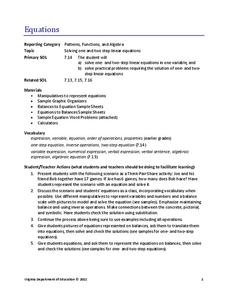
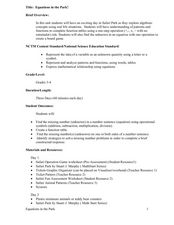
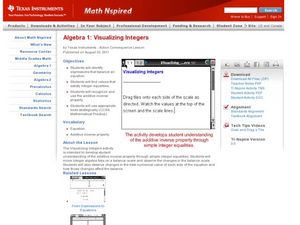



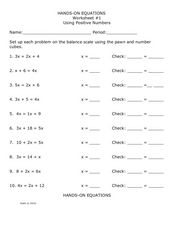


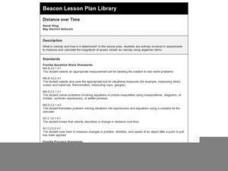

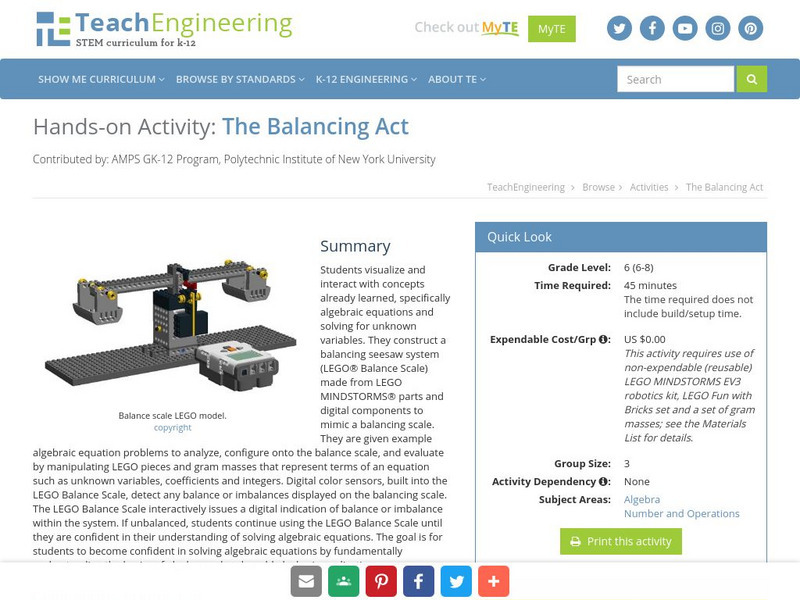
![Inside Mathematics: Boxes [Pdf] Lesson Plan Inside Mathematics: Boxes [Pdf] Lesson Plan](https://d15y2dacu3jp90.cloudfront.net/images/attachment_defaults/resource/large/FPO-knovation.png)

